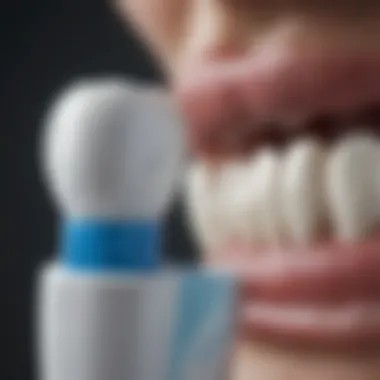Examining the Safety of Fluoride Toothpaste: An In-Depth Analysis


Intro
The discussion around fluoride toothpaste often sparks intense debate. Fluoride is a naturally occurring mineral known for its role in preventing dental cavities. While many health organizations advocate for its use, there are contrasting views on its safety. This article seeks to unpack these complexities, providing insight into scientific findings and public opinions.
Research Overview
Summary of Key Findings
Recent studies have highlighted the benefits of fluoride in oral health. Several meta-analyses confirm that fluoride toothpaste significantly reduces the incidence of tooth decay. However, there is concern regarding excessive fluoride exposure, leading to conditions such as dental fluorosis. Critics argue for caution, especially in young children who may swallow toothpaste inadvertently.
Research Objectives and Hypotheses
The main aim of this research is to critically evaluate the safety profile of fluoride toothpaste. We hypothesize that while controlled use of fluoride is beneficial, unregulated consumption may pose health risks. Understanding these dynamics can aid consumers and health professionals in making informed choices regarding dental care.
Methodology
Study Design and Approach
This analysis follows a systematic literature review approach. We scrutinized peer-reviewed studies, government reports, and comprehensive reviews published in reputable journals. This methodology allows for a well-rounded view of the available evidence regarding fluoride toothpaste.
Data Collection Techniques
Data was collected through various channels:
- Peer-reviewed Journals: High-impact journals provided insights into research findings related to fluoride’s efficacy and safety.
- Government and Health Organization Reports: Documents from entities like the World Health Organization and American Dental Association offered authoritative perspectives.
- Public Surveys and Interviews: Gathering opinions from both healthcare professionals and consumers highlighted real-world concerns and experiences regarding toothpaste safety.
"Understanding the nuances of fluoride exposure is essential for effective dental health management."
With these elements defined, the article will further explore the regulatory framework surrounding fluoride toothpaste, its benefits and drawbacks, and alternative dental health options available today.
Prelude to Fluoride Toothpaste
Fluoride toothpaste is a staple in modern dental hygiene, widely recommended for its ability to prevent cavities and enhance dental health. Yet, the topic sparks much debate among researchers, healthcare providers, and the public alike. Understanding the role of fluoride in oral care is crucial for informed decision-making about its use.
Understanding Fluoride
Fluoride is a naturally occurring mineral found in various environmental sources, including soil, water, and certain foods. It promotes mineralization, strengthening teeth and providing resistance against decay. The effectiveness of fluoride in preventing cavities is well-documented in numerous clinical studies.
When people brush their teeth with fluoride toothpaste, they introduce fluoride into their mouths, allowing it to actively remineralize tooth enamel. This process helps repair early signs of decay before they develop into cavities.
Creating an informed understanding of fluoride's benefits is essential, as it helps assess the product's overall safety profile. While fluoride provides undeniable advantages in oral health, it is essential to balance these with the potential risks associated with excessive exposure.
Historical Context
The use of fluoride in dental care has a rich history, dating back to the early 20th century. In the 1940s, researchers in the United States began to notice a correlation between fluoride exposure and reduced cavity rates. This led to the widespread addition of fluoride to municipal water supplies and the eventual development of fluoride toothpaste.
In subsequent decades, public health organizations, including the American Dental Association, endorsed fluoride's efficacy. However, as awareness of potential risks has grown, some communities have adopted measures to limit fluoride use.
Understanding fluoride's historical context helps explain the mixed perceptions surrounding its use today. The early successes in reducing dental caries contributed to a strong belief in fluoride's benefits, while evolving concerns about safety have fueled ongoing debate in both scientific and public realms.
Health Benefits of Fluoride
Fluoride has long been recognized for its positive impact on dental health. Understanding the health benefits of fluoride is crucial when evaluating its role in oral care. In particular, fluoride is credited with significantly reducing the incidence of cavities, which is the main focus of dental health initiatives worldwide. Additionally, fluoride plays a vital part in dental remineralization, a process that restores minerals to the teeth's enamel after it has been compromised.


Cavity Prevention
One of the primary benefits of fluoride toothpaste is its efficacy in cavity prevention. Studies indicate that fluoride helps to form a protective barrier on the teeth, effectively inhibiting the production of acids by bacteria in the mouth. These acids are responsible for demineralizing tooth enamel and leading to cavities.
The mechanism is straightforward: when fluoride is present in the mouth, it enhances the remineralization process. This involves the absorption of essential minerals, such as calcium and phosphate, back into the enamel. By doing this, fluoride effectively repairs early signs of decay before they progress to more serious dental issues. Regular use of fluoride toothpaste can drastically reduce the likelihood of cavity formation.
Research conducted by the American Dental Association highlights that communities with fluoridated drinking water have lower rates of dental caries compared to those without it. This evidence supports the argument for incorporating fluoride into daily oral hygiene routines.
Dental Remineralization
Another significant aspect of fluoride's benefits is its promotion of dental remineralization. This process is essential for maintaining strong and healthy teeth. Fluoride not only helps to rebuild enamel but also enhances the tooth's resistance to future decay.
During remineralization, fluoride ions can replace lost minerals, effectively strengthening the enamel. This process can occur naturally, but the presence of fluoride accelerates it. Moreover, fluoride can also help to manage early decay by halting its progression. The incorporation of fluoride in oral care products facilitates a protective mechanism that helps in keeping the teeth robust against acid attacks.
"Fluoride has been shown to be instrumental in cavity prevention and dental health, making it a common recommendation among dental professionals."
In summary, the health benefits of fluoride are substantial. It is essential for readers, especially students, researchers, and educators in the field of health, to grasp the importance of fluoride in dental health. Effective use of fluoride toothpaste can lead to healthier teeth and a lower incidence of dental problems.
Fluoride Exposure: Sources and Types
Understanding the various sources and types of fluoride exposure is crucial in assessing the overall safety of fluoride toothpaste. Fluoride is present in several aspects of our environment, and its levels can vary. This knowledge helps to frame the discussions around dental products containing fluoride, especially for those concerned about their use. By identifying both natural and anthropogenic sources, consumers can better comprehend potential risks and benefits associated with fluoride.
Natural Fluoride Sources
Fluoride occurs naturally in water, soil, and certain foods. Its presence in water sources is particularly significant, as it varies greatly depending on geographic location. For example, some areas have naturally high fluoride concentrations, while others may have minimal amounts.
Here are common natural sources of fluoride:
- Drinking Water: Some groundwater has fluoride levels that exceed the optimal levels recommended for dental health. Regions with higher natural fluoride might present a risk of overexposure.
- Food: Certain foods such as tea, fish, and some fruits can contain fluoride. The levels in these foods, while typically lower than that found in toothpaste, still contribute to overall fluoride intake.
- Dental Plaque: It can also contain fluoride from saliva and various sources we consume.
Natural exposure tends to be more consistent and is often part of everyone's diet. Understanding these sources is vital for making informed choices about using fluoride toothpaste, especially in areas with high natural fluoride levels.
Industrial and Environmental Sources
Apart from natural sources, fluoride is also released into the environment through various industrial processes. This exposure can influence the total intake of fluoride among populations. Industrial sources can lead to environmental contamination, raising health concerns. Some key sources include:
- Phosphate Fertilizers: These often contain fluoride, which can leach into groundwater and surrounding ecosystems.
- Aluminum Production: Industrial activities associated with aluminum manufacturing release fluoride compounds, impacting local air and water quality.
- Fluoride Emission from Factories: Several industries discharge fluoride into the atmosphere, which can settle on land and water bodies.
Awareness of these industrial sources helps people discern the levels of fluoride that might not be due solely to dental products. The extra exposure from various sources complicates the picture, especially in terms of assessing the safety of products like fluoride toothpaste.
In assessing fluoride's safety, both natural and industrial sources must be considered to understand exposure levels fully.
Understanding fluoride exposure through different channels lays the foundation for evaluating the overall safety of fluoride toothpaste. This knowledge enables stakeholders—be they consumers, researchers, or healthcare professionals—to make informed decisions when choosing dental care products.
Clinical Concerns Over Fluoride Use
The use of fluoride toothpaste has been a subject of significant discussion in recent years. While fluoride is known to play a pivotal role in preventing cavities, the potential risks associated with its use warrant a careful examination. This section will review clinical concerns related to fluoride, focusing on dental fluorosis and any potential systemic effects that may arise from excessive fluoride exposure.
Dental Fluorosis
Dental fluorosis occurs when children ingest too much fluoride during the years of tooth development. This condition affects the appearance of enamel. It can present as white spots, streaks, or more severe discoloration on teeth. The severity often depends on the amount of fluoride exposure.
- Risk Factors:
- Incidence:
Fluorosis is primarily aesthetic rather than detrimental to dental health but can cause concern among parents and patients.
- Age: Children under the age of eight are particularly vulnerable.
- Source: fluoride in drinking water, supplements, and fluoride toothpaste.


In some cases, it can lead to public health discussions on how much fluoride is safe for children. Dental professionals often recommend monitoring and limiting fluoridated toothpaste use for young kids to reduce this risk. Some alternative options exist that use non-fluoride ingredients but may lack the same proven effectiveness against cavities.
Potential Systemic Effects
While dental fluorosis is well-documented, questions about potential systemic effects of fluoride remain. Some studies suggest fluoride may have implications beyond dental health, particularly concerning the skeletal system and endocrine functions.
- Skeletal Fluorosis:
This condition arises from excessive fluoride exposure over time. It can lead to rigidity of bones and joint issues. - Endocrine Disruption:
There is growing concerns about fluoride's effect on hormonal systems, particularly in developing systems. Ingesting large amounts may interfere with hormone balance and functions.
Research in these areas continues, as determining safe exposure levels is crucial. Current recommendations by organizations like the World Health Organization guide fluoride use, but systematic review is needed to further clarify potential risks.
According to recent studies, monitoring fluoride levels in commonly used products like toothpaste is essential to ensure safety, particularly in vulnerable populations.
In summary, while fluoride has benefits, the concerns over dental fluorosis and potential systemic effects necessitate a balanced approach. Evaluating these issues allows consumers to make informed choices about their dental health products.
Key Studies and Findings
Research regarding fluoride toothpaste has produced a variety of important findings. These studies are critical as they provide the scientific backing necessary for understanding the safety and efficacy of fluoride in dental care. Delving into systematic reviews and longitudinal studies offers valuable insights into how fluoride affects oral health and the implications of its widespread use.
Systematic Reviews
Systematic reviews synthesize data from multiple studies, providing a comprehensive overview of existing research. One key review published in the Cochrane Database of Systematic Reviews highlighted the benefits of fluoride in reducing cavities. The review encompassed numerous trials and established that fluoride toothpaste is effective in preventing dental caries in children and adolescents.
Additionally, systematic reviews can uncover potential concerns. For example, some studies indicated a correlation between high fluoride exposure and dental fluorosis. Analyzing these reviews provides a balanced view, weighing fluoride's benefits against potential risks.
In summary, systematic reviews contribute to evidence-based dental practice, guiding health professionals and informing public health policies.
Longitudinal Studies
Longitudinal studies track the same subjects over time, offering insights into the long-term effects of fluoride toothpaste. One notable study conducted in Canada observed the dental health of children from infancy to adolescence. The findings indicated a significant reduction in cavity rates among those who used fluoride toothpaste regularly.
Furthermore, these studies help assess the safety of fluoride use across different populations. By examining various age groups, researchers can identify any adverse effects that may arise from long-term exposure to fluoride. For instance, a long-term study in the United States raised questions about a possible link between fluoride use and adverse neurodevelopmental outcomes, leading to further investigation.
Regulatory Perspectives
The regulatory perspective surrounding fluoride toothpaste is essential for understanding its safety and efficacy. Regulatory agencies play a crucial role in setting guidelines and standards for the use of fluoride in dental products. This is particularly important given the ongoing debates about the benefits and risks associated with fluoride use. Evaluating how laws and recommendations are formed helps clarify the framework that governs the usage of fluoride.
World Health Organization Guidelines
The World Health Organization (WHO) has established guidelines that are designed to promote oral health while ensuring that fluoride use remains safe. According to WHO, fluoride has been recognized for its cavity-preventing properties. Their guidelines suggest an optimal concentration of fluoride in toothpaste to balance efficacy against potential risks. WHO encourages countries to adopt these recommendations to improve public health outcomes.
These guidelines also highlight the importance of educating consumers about proper oral hygiene practices. Public awareness campaigns can significantly reduce the risk of overexposure to fluoride, particularly in children. For instance, WHO has recommended that parents supervise their children’s brushing habits to prevent excess ingestion of toothpaste. This responsibility underscores the broader role of health organizations in consumer education.
National Regulatory Frameworks
In addition to WHO guidelines, various national regulatory frameworks influence the use of fluoride toothpaste. Each country may have different specifications regarding the allowable fluoride concentrations in dental products. For example, in the United States, the Food and Drug Administration (FDA) oversees the safety and marketing of fluoride toothpaste. The FDA establishes specific criteria, which must be met before products can be marketed as safe and effective.
Regulatory frameworks often also assess health claims made by manufacturers. This vigilance helps ensure that consumers receive truthful information about the benefits of fluoride toothpaste without misleading advertisements. Furthermore, it's vital for regulatory bodies to continue updating their protocols based on emerging research.
Regular assessments can help mitigate any potential health risks associated with fluoride, addressing concerns such as dental fluorosis and systemic effects. Thus, attention to regulatory measures is crucial for balancing effective oral health initiatives with public safety.
"Regulations are not just rules; they are the guidance that helps maintain public trust in health products."
Public Perception and Controversies


Public perception around fluoride toothpaste is a dynamic area that demands attention. Understanding how fluoride is viewed can shape health decisions made by consumers. The efficacy of fluoride in preventing cavities is widely recognized in the dental community. However, this widespread acceptance contrasts sharply with concerns raised by segments of the population regarding its safety. As such, the discussion is not just scientific; it is exemplary of how public health information can diverge into conflicting narratives.
One major element drawing public scrutiny is the historical context of fluoride use. Research from the mid-20th century has shown that fluoride can significantly reduce rates of dental caries. Yet, as the scientific community continued to endorse fluoride, some began to question the overarching narrative. Critics argue that continued exposure, especially in young children, can lead to adverse effects. This controversy stems from differing interpretations of scientific findings and the perceived risks that may arise from fluoride overuse.
Moreover, grassroots movements have emerged that highlight alternative health perspectives. Many advocate for the use of natural oral care products, emphasizing the potential harms of chemical additives. This movement contrasts with mainstream health recommendations that support fluoridated products. The challenge lies in balancing scientific consensus with public sentiment.
The divide between scientific endorsement and public doubt regarding fluoride use reflects broader societal trends where health protocols and individual choices often clash.
Debates in the Scientific Community
Disagreements within the scientific community significantly influence public perception of fluoride toothpaste. Some researchers argue vehemently for fluoride’s continuing role in preventive dentistry, citing extensive studies demonstrating its benefits. They reference systematic reviews showing a consistent correlation between fluoride use and decreased tooth decay.
On the opposing side, a growing cohort of scientists is voicing concerns about the long-term effects of fluoride exposure. Their arguments often center on dental fluorosis, a condition resulting from excessive fluoride intake during childhood. Furthermore, these scientists call for deeper investigation into potential systemic effects, asserting that current studies may not fully capture the long-term health implications.
Influence of Misinformation
Misinformation plays a crucial role in shaping public opinion about fluoride toothpaste. Various platforms host numerous discussions, often based on unverified claims rather than empirical evidence. Social media, for example, allows for rapid dissemination of fear-driven narratives, sometimes overshadowing scientific facts.
A notable aspect is how misinformation can polarize the audience. Terms like "toxic" and "poison" often appear in discussions, framing fluoride in a negative light. This skewed perspective can discourage individuals from using fluoride, even when health organizations advocate for its safety in regulated amounts.
Furthermore, ongoing debates across forums such as Reddit and Facebook often amplify fears without scientific backing. Engaging in a more informed dialogue becomes crucial, as it can help separate fact from fiction and contribute to sound decision-making regarding oral health.
Alternatives to Fluoride Toothpaste
In recent years, the discussion surrounding fluoride toothpaste has intensified, prompting many consumers to seek alternatives. The reasons for this shift range from concerns regarding potential health risks associated with fluoride exposure to personal preference for more natural products. Understanding these alternatives is vital for those looking to maintain oral health without the inclusion of fluoride in their dental hygiene regime. The examination of alternatives invites not only critical evaluation of products but also an analysis of efficacy, safety, and suitability for individual needs.
Natural Oral Care Products
Natural oral care products have gained popularity as consumers have become more health-conscious and increasingly skeptical about synthetic additives. These products encompass a variety of items, often made from plant-derived ingredients. Common components include baking soda, coconut oil, tea tree oil, and various essential oils. Many users appreciate the perceived benefits of these natural alternatives:
- Baking Soda: This common ingredient helps in reducing plaque and neutralizing acidity, which can be beneficial in preventing cavities.
- Coconut Oil: Known for its antibacterial properties, coconut oil is used in oil pulling, a practice believed to enhance oral health by reducing harmful bacteria in the mouth.
- Essential Oils: Oils such as peppermint and clove can provide additional antimicrobial benefits and freshness to breath.
It is important to note that while these natural products offer certain advantages, they may not provide the same level of protection as fluoride. The effectiveness of these products can vary widely, and some consumers may need to conduct personal trials to find what works best for them.
Home Remedies
Home remedies for oral care often draw upon traditional practices passed down through generations. These methods typically involve readily available ingredients which aim to support dental health without the use of fluoride. Some popular home remedies include:
- Saltwater Rinse: A saline solution can help reduce swelling and cleanse the mouth, promoting general oral health.
- Apple Cider Vinegar: Its antibacterial properties make it a favored choice for some individuals looking to maintain oral hygiene.
- Activated Charcoal: Though controversial, activated charcoal is sometimes used for its teeth whitening properties and ability to absorb toxins.
While these remedies can be appealing due to their simplicity and natural origins, scientific backing for their efficacy may be limited. Therefore, it is crucial for individuals to approach these options with caution and consider their personal circumstances.
Finale: Weighing the Risks and Benefits
In exploring the safety of fluoride toothpaste, it is crucial to assess both its advantages and potential drawbacks. The body of evidence underscores fluoride's significant role in preventing dental caries and promoting enamel health. However, concerns about excessive fluoride exposure, particularly in children, cannot be dismissed lightly. This resulting tension between its benefits and potential risks necessitates a balanced analysis. This section serves to synthesize the main points discussed throughout the article, offering clarity on the topic for both health professionals and consumers.
Future Research Directions
Future research should take a multifaceted approach to evaluate the intricate balance of fluoride use in dental health. Areas for further investigation include:
- Long-Term Effects: Understanding the chronic effects of fluoride over extended periods can inform guidelines on usage.
- Population Studies: Gathering data from diverse demographic backgrounds will help clarify how variations in fluoride impact different communities.
- Alternative Treatments: Researching substitutes that may provide similar benefits without associated risks could be valuable.
It is essential to continually monitor the evolving literature surrounding fluoride to reassess recommendations as new findings emerge.
Informed Consumer Choices
Informed decision-making is critical for consumers navigating the complexities of dental care. Some key considerations include:
- Product Selection: Not all fluoride toothpaste brands are identical. Comparing fluoride concentrations can help individuals choose suitable products for their specific needs.
- Awareness of Risks: Understanding dental fluorosis and its implications is vital for parents when selecting toothpaste for young children.
- Consulting Professionals: Engaging with dental health professionals can provide personalized advice based on individual health profiles.
As consumers become more educated, they can optimally choose dental care products, balancing safety concerns with the benefits of fluoride.















